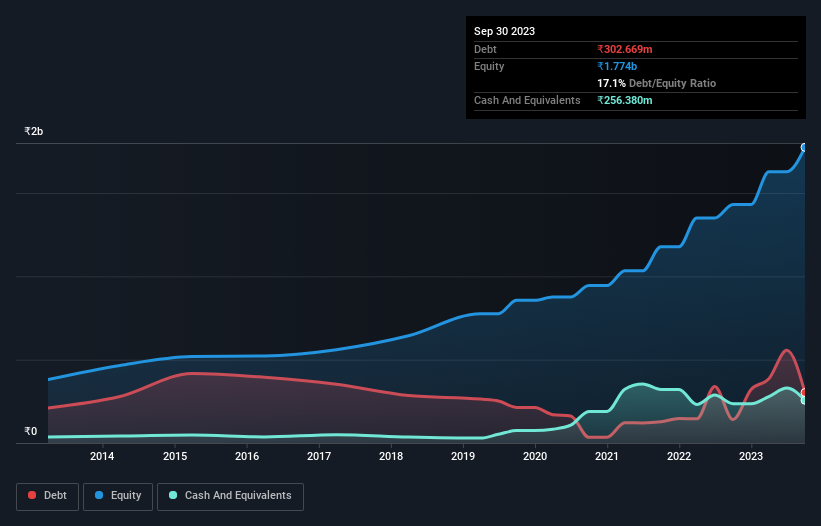
Some say volatility, rather than debt, is the best way to think about risk as an investor, but Warren Buffett famously said that 'Volatility is far from synonymous with risk.' When we think about how risky a company is, we always like to look at its use of debt, since debt overload can lead to ruin. As with many other companies Roto Pumps Limited (NSE:ROTO) makes use of debt. But should shareholders be worried about its use of debt?
Why Does Debt Bring Risk?
Debt is a tool to help businesses grow, but if a business is incapable of paying off its lenders, then it exists at their mercy. If things get really bad, the lenders can take control of the business. However, a more usual (but still expensive) situation is where a company must dilute shareholders at a cheap share price simply to get debt under control. Of course, the upside of debt is that it often represents cheap capital, especially when it replaces dilution in a company with the ability to reinvest at high rates of return. When we examine debt levels, we first consider both cash and debt levels, together.
Check out our latest analysis for Roto Pumps
How Much Debt Does Roto Pumps Carry?
As you can see below, at the end of September 2023, Roto Pumps had ₹302.7m of debt, up from ₹140.8m a year ago. Click the image for more detail. However, it does have ₹256.4m in cash offsetting this, leading to net debt of about ₹46.3m.

How Strong Is Roto Pumps' Balance Sheet?
Zooming in on the latest balance sheet data, we can see that Roto Pumps had liabilities of ₹870.2m due within 12 months and liabilities of ₹160.2m due beyond that. On the other hand, it had cash of ₹256.4m and ₹517.4m worth of receivables due within a year. So its liabilities outweigh the sum of its cash and (near-term) receivables by ₹256.6m.
Having regard to Roto Pumps' size, it seems that its liquid assets are well balanced with its total liabilities. So while it's hard to imagine that the ₹14.0b company is struggling for cash, we still think it's worth monitoring its balance sheet. But either way, Roto Pumps has virtually no net debt, so it's fair to say it does not have a heavy debt load!
We measure a company's debt load relative to its earnings power by looking at its net debt divided by its earnings before interest, tax, depreciation, and amortization (EBITDA) and by calculating how easily its earnings before interest and tax (EBIT) cover its interest expense (interest cover). This way, we consider both the absolute quantum of the debt, as well as the interest rates paid on it.
With debt at a measly 0.07 times EBITDA and EBIT covering interest a whopping 16.6 times, it's clear that Roto Pumps is not a desperate borrower. Indeed relative to its earnings its debt load seems light as a feather. In addition to that, we're happy to report that Roto Pumps has boosted its EBIT by 46%, thus reducing the spectre of future debt repayments. When analysing debt levels, the balance sheet is the obvious place to start. But it is Roto Pumps's earnings that will influence how the balance sheet holds up in the future. So when considering debt, it's definitely worth looking at the earnings trend. Click here for an interactive snapshot.
Finally, a company can only pay off debt with cold hard cash, not accounting profits. So we always check how much of that EBIT is translated into free cash flow. In the last three years, Roto Pumps created free cash flow amounting to 2.7% of its EBIT, an uninspiring performance. That limp level of cash conversion undermines its ability to manage and pay down debt.
Our View
Happily, Roto Pumps's impressive interest cover implies it has the upper hand on its debt. But the stark truth is that we are concerned by its conversion of EBIT to free cash flow. Taking all this data into account, it seems to us that Roto Pumps takes a pretty sensible approach to debt. While that brings some risk, it can also enhance returns for shareholders. When analysing debt levels, the balance sheet is the obvious place to start. But ultimately, every company can contain risks that exist outside of the balance sheet. These risks can be hard to spot. Every company has them, and we've spotted 2 warning signs for Roto Pumps (of which 1 is a bit unpleasant!) you should know about.
Of course, if you're the type of investor who prefers buying stocks without the burden of debt, then don't hesitate to discover our exclusive list of net cash growth stocks, today.
New: AI Stock Screener & Alerts
Our new AI Stock Screener scans the market every day to uncover opportunities.
• Dividend Powerhouses (3%+ Yield)
• Undervalued Small Caps with Insider Buying
• High growth Tech and AI Companies
Or build your own from over 50 metrics.
Have feedback on this article? Concerned about the content? Get in touch with us directly. Alternatively, email editorial-team (at) simplywallst.com.
This article by Simply Wall St is general in nature. We provide commentary based on historical data and analyst forecasts only using an unbiased methodology and our articles are not intended to be financial advice. It does not constitute a recommendation to buy or sell any stock, and does not take account of your objectives, or your financial situation. We aim to bring you long-term focused analysis driven by fundamental data. Note that our analysis may not factor in the latest price-sensitive company announcements or qualitative material. Simply Wall St has no position in any stocks mentioned.
About NSEI:ROTO
Roto Pumps
Engages in the manufacture and sale of pumps and spare parts in India.
Flawless balance sheet average dividend payer.
Similar Companies
Market Insights
Community Narratives




